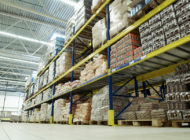The hot summer vs the climate-controlled warehouse. Products that must remain within a specific temperature range, such as food and pharmaceutical goods, are especially vulnerable to the heat and humidity of the summer months. Here in North Carolina, we know a little about Summer heat!
Logistics companies who handle these products must therefore be adept at climate-controlled warehousing – the ability to ensure that product temperature stays within proper range every moment the items are on premises.
In this post, we’ll give you a glimpse into what we do at Kanban to ensure temperature consistency 24/7/365.
Climate-Controlled Warehousing
 Food and pharmaceutical products with very specific temperature requirements will typically be housed in a “climate-controlled” warehouse. During the summer, we here at Kanban pay special attention to the following factors.
Food and pharmaceutical products with very specific temperature requirements will typically be housed in a “climate-controlled” warehouse. During the summer, we here at Kanban pay special attention to the following factors.
Cooling. When dealing with a climate-controlled space, large cooling units must be placed strategically throughout that space to maintain the desired range throughout. During the summer months, these units may need to be moved and/or additional units may be needed to maintain the desired temperature. In addition to seasonal fluctuations, factors such as ceiling height, insulation density, and the warehouse’s building material(s) help to determine the quantity and placement of cooling units.
Monitoring. Having the right number of cooling units in the right places is only half of the equation. Climate-controlled warehouse space must be monitored 24/7 to ensure that temperature and humidity levels stay within spec. For Kanban’s food warehousing spaces and equipment, we have our own internal monitoring system but also enjoy the added security of being monitored by an external company simultaneously. Extra attention is given to readings throughout the summer months.
Racking. With our narrow/double-deep racking system, we’re able to allow for more products to be housed within a smaller footprint. Since climate-controlled space tends to be more expensive space, efficient storage can result in major cost savings.
Conservation. Did your parents ever tell you to “close the door, you’re letting the air out?” Well, the same principle applies to the warehouse. During the summer, when dock doors and other facility doors are open, cold air escapes and hot/humid air gets in. If this is repeated throughout the day, the condition of our climate-controlled spaces can be compromised. To combat this, we have state-of-the-art, insulated doors that open and close with the push of a button, along with an associate-training program to reinforce the importance of a tight seal on buildings and areas.
Is Your 3PL Climate-Control Savvy?
If you outsource warehousing to a third-party logistics provider, you rely on them to maintain the integrity of your products – at the appropriate temperature. A couple of degrees in temperature variance one way or the other can result in having to discard huge amounts of product for quality reasons.
You’ve selected your partner because you trust their ability to manage a temperature-controlled warehouse. But take a cue from Ronald Reagan: Trust but verify.
Tour the operation and ask the tough questions: about the accuracy of monitoring gauges, temperature reporting, training for associates, and alert processes when temperature readings fall out of range. Look for a full understanding of the issues not only from executives, but from the associates on the floor.
Summer months put the biggest stress on climate-controlled warehousing. Now is probably a good time to audit your own processes, or those of your partners.
If you need help storing and distributing temperature-sensitive products in North Carolina, contact Kanban and let’s talk.


